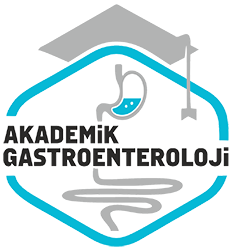Agustos 2022
karaciğer hastalıklarinda kullanilan skorlamalar malign-benign kolestaz ayriminda kullanilabilir mi?
Can the scoring used in liver diseases be used to differentiate malignant and benign cholestasis?
- Ana Sayfa
- Sayılar
- Agustos 2022
- karaciğer hastalıklarinda kullanilan skorlamalar malign-benign kolestaz ayriminda kullanilabilir mi?...
Özet
Giriş ve Amaç: Kronik safra yolu hastalıklari hepatositlerde bilirübin ve karacigerden ekskrete edilen toksinlere daha uzun süre maruziyete neden olarak hepatositfonksiyonlarini bozmaktadır. Ayrıca karacigerin primer maligniteleri gibi safra yolu malignitelerinin de fibrotik karakterde olduğunu öne süren yayinlar vardır. Bu bilgilerisiginda kronik ve malign safra yolu tikanikligi olusturan kolestatik hastalıkların, akut ve benign safra yolu tikanikligi olusturan hastalıklara göre karaciger fonksiyonlarinidaha fazla bozdugu ve karaciger fibrozisini artirdigi düsünülebilir. Çalışmamızda rutin testlerle ölçülebilen ve karaciger hastalıklarında kullanılan skorlardan; R-faktör, sondönem karaciger hastalığı modeli/sodyum, albümin-bilirübin skoru, albümin-alkalen fosfataz orani, aspartat aminotransferaz-trombosit oran indeksi, dört faktörü temelalan fibrozis indeksi (fibrozis-4) ve gama glutamil transpeptidaz-trombosit orani’ndan hangilerinin malign nedenli kolestaz tanısıni koymakta yardimci bir yöntem olarakkullanilabileceginin arastirilmasi hedeflenmıştır. Gereç ve Yöntem: Ondokuz Mayis Üniversitesi Tıp Fakültesi Gastroenteroloji Klinigi’nde Temmuz 2019 - Temmuz2021 tarihleri arasında obstrüktif kolestaz tanısı alan Hastaların dosyalari retrospektif olarak tarandi. Akut ve benign nedenli kolestaz tanısı alan hastalar Grup 1, kronik vemalign nedenli kolestaz tanıli hastalar Grup 2 olarak siniflandirildi. Hastaların ilk başvuru zamanindaki laboratuvar değerleri kullanilarak; R-faktör, son dönem karacigerhastalığı modeli/sodyum, albümin-bilirübin skoru, albümin-alkalen fosfataz orani, aspartat aminotransferaz-trombosit oran indeksi, fibrozis-4 indeksi ve gama glutamiltranspeptidaz-trombosit orani skorlari hesaplandi, tanılari ile tanı anindaki skorlari arasındaki ilişki değerlendirildi. Bulgular: çalışmaya 116’sı erkek (%57.4), 86’sı kadın(%42.6) toplam 202 hasta dahil edildi. Grup 1’de 92 (%45.5), Grup 2’de 110 (%54.5) hasta yer almaktaydi. Grup 1 ve Grup 2 arasında demografik özellikler açısındananlamli fark görülmedi. Grup 1’de sik görülen hastalıklar kolanjit, koledokolitiazis ve safra çamuru ile biliyer pankreatit iken Grup 2’de ise pankreas basi karsinomuydu.değerlendirilen laboratuvar parametrelerinden alkalen fosfataz, total ve direkt bilirübin maligniteye isaret eden en önemli testlerdi (p < 0.001). Karaciger hastalığı skorlarindan R-faktör (p < 0.001), son dönem karaciger hastalığı modeli/sodyum (p < 0.001) ve albümin-bilirübin skoru (p = 0.023) Grup 2, albümin-alkalen fosfataz orani (p< 0.001), aspartat aminotransferaz-trombosit oran indeksi (p < 0.001) ve fibrozis-4 indeksi (p < 0.001) Grup 1 lehine anlamliydi ancak gama glutamil transpeptidaz-trombosit orani için her iki grup arasında anlamli fark yoktu (p = 0.242). tanı konma süreçleri içinde Grup 1’deki Hastaların nihai tanılari çogunlukla ultrasonografi ile konmaktaiken (p < 0.001), Grup 2’deki hastalar bilgisayarli tomografi ile tanı almaktaydi (p < 0.001). Sonuç: Çalışmamız kronik karaciger hastalıklarında kullanılan skorlardanR-faktör, son dönem karaciger hastalığı modeli/sodyum ve albümin-bilirübin skoru malign nedenli kolestatik hastalıkların tanısında, albümin-alkalen fosfataz orani,aspartat aminotransferaz-trombosit oran indeksi ve fibrozis-4 indeksinin benign nedenli kolestatik hastalıkların tanısında yardimci bir yöntem olarak kullanilabilecegini,gama glutamil transpeptidaz-trombosit oraninin ise bu ayirimda kullanilamayacagini göstermektedir. Bu tip öngörücü skorlar, anamnez ve muayene bulgulari ile birlikteyorumlanarak Hastaların tetkik ve tedavi planlarinin daha hizli saglanmasini kolaylastirabilir.
Abstract
Background and Aims: Chronic biliary tract diseases impair hepatocyte functions by causing longer exposure to bilirubin in hepatocytes and toxins excreted from theliver. In addition, there are publications suggesting that biliary tract malignancies, like primary malignancies of the liver, are also characterized by fibrosis. In the light ofthis information, it can be thought that cholestatic diseases that cause chronic and malignant bile duct obstruction worsen liver functions and increase liver fibrosis thandiseases that cause acute and benign biliary tract obstruction. In our study, we aimed to investigate which scoring systems used in liver diseases (R-factor, the model forend-stage liver disease-natrium, albumin-bilirubin score, alkaline phosphatase-to-platelet ratio, aspartate aminotransferase to platelet ratio index, fibrosis-4 score andgamma-glutamyl transpeptidase-to-platelet ratio) could be used as an auxiliary method in the diagnosis of malignant cholestasis. Material and Method: The files ofpatients who were diagnosed with obstructive cholestasis in Ondokuz Mayis University Faculty of Medicine, Gastroenterology Clinic between July 2019 and July 2021were reviewed retrospectively. Patients diagnosed with acute and benign cholestasis were classified as Group 1, and patients with chronic and malignant cholestasiswere classified as Group 2. Using the laboratory values of the patients at the time of first application; R-factor, the model for end-stage liver disease-natrium, albumin-bilirubin score, alkaline phosphatase-to-platelet ratio, aspartate aminotransferase to platelet ratio index, fibrosis-4 score and gamma-glutamyl transpeptidase-to-plateletratio scores were calculated, and the relationship between their diagnosis and their scores at the time of diagnosis was evaluated. Results: A total of 202 patients,116 male (57.4%) and 86 female (42.6%), were included in the study. There were 92 (45.5%) patients in Group 1 and 110 (54.5%) patients in Group 2. There was nosignificant difference between Group 1 and Group 2 in terms of demographic characteristics. Common diseases were cholangitis, choledocholithiasis, biliary sludge andbiliary pancreatitis in Group 1, and pancreatic head carcinoma in Group 2, respectively. Among the laboratory parameters, alkaline phosphatase, total and direct bilirubinwere the most important tests indicating malignancy (p < 0.001). Among the liver disease scores; R-factor (p < 0.001), the model for end-stage liver disease-natrium (p< 0.001) and albumin-bilirubin score (p = 0.023) were significant in favor of Group 2, while alkaline phosphatase-to-platelet ratio (p < 0.001), aspartate aminotransferaseto platelet ratio index (p < 0.001) and fibrosis-4 score (p < 0.001) were significant in favor of Group 1, but there was no significant difference between the two groups interms of gamma-glutamyl transpeptidase-to-platelet ratio (p = 0.242). The final diagnosis of the patients in Group 1 was mostly made by ultrasonography (p < 0.001),whereas the patients in Group 2 were diagnosed with computed tomography (p < 0.001). Conclusion: Our study showed that R-factor, the model for end-stage liverdisease-natrium and albumin-bilirubin score could be used as an auxiliary method in the diagnosis of malignant cholestatic diseases. Alkaline phosphatase-to-plateletratio, aspartate aminotransferase to platelet ratio index and fibrosis-4 score could be used as an auxiliary method in the diagnosis of benign cholestatic diseases. However, gamma-glutamyl transpeptidase-to-platelet ratio could not be used in this distinction. Such predictive scores could be interpreted together with the anamnesis andexamination findings, making it easier for patients to be examined and treated more quickly.



